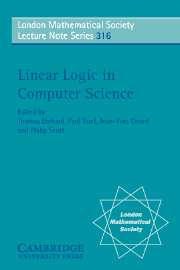2 - Proof Nets and the λ-Calculus
Published online by Cambridge University Press: 17 May 2010
Summary
Abstract
In this survey we shall present the main results on proof nets for the Multiplicative and Exponential fragment of Linear Logic (MELL) and discuss their connections with λ-calculus. The survey ends with a short introduction to sharing reduction. The part on proof nets and on the encoding of λ-terms is self-contained and the proofs of the main theorems are given in full details. Therefore, the survey can be also used as a tutorial on that topics.
Introduction
In his seminal paper on Linear Logic, Girard introduced proof nets in order to overcome some of the limitations of the sequent calculus for Linear Logic. At the price of the loss of the symmetries of sequents, proof nets allowed to equate proofs that in sequent calculus differ by useless details, and gave topological tools for the characterization and analysis of Linear Logic proofs. Moreover, because of the encoding of λ-calculus in the Multiplicative and Exponential fragment of Linear Logic (MELL), it was immediately clear that proof nets might have become a key tool in the fine analysis of the reduction mechanism, the dynamics, of Acalculus. Such a property was even clearer after that Girard introduced GOI (Geometry of Interaction) and after the work by Danos and Regnier on the so-called local and asynchronous β-reduction. However, the key step towards the full exploitation of proof nets in the analysis of λ-calculus dynamics was the discover by Gonthier et al. that Lamping's algorithm for the implementation of λ-calculus optimal reduction might be reformulated on proof nets using GOI.
- Type
- Chapter
- Information
- Linear Logic in Computer Science , pp. 65 - 118Publisher: Cambridge University PressPrint publication year: 2004
- 3
- Cited by



